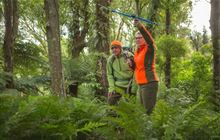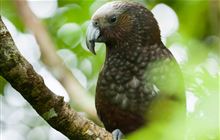Birds inventory and monitoring
Introduction
This module describes methods to inventory and monitor birds and bird communities.How to use this module
- Read project planning guides.
- Read themethods to inventory and monitor birds.
- Consult the introduction and the comparative tables and decision trees to help you select the method(s) most appropriate for your study.
- Be aware of the minimum data collection standards for methods.
- Check if any training is available for this method.
Introduction
How to decide the best method for bird monitoring (PDF, 992K)
Read this introduction and consult the comparative tables and decision trees to help you decide the method(s) best suited for your project objectives.
Methods
Complete counts
The following methods can be used as complete counts of a population. Complete counts assume that that all individuals within the sampled area or plot are detected.
True census of bird population (PDF, 818K)
This method is suitable for use within a restricted area and habitat where individual birds are easily detected, or on small spatial scales. In all cases it must be certain that all individuals can be counted.
Ground-based photo counts for seabirds (PDF, 757K)
This method is suitable for counting colonial surface-nesting seabirds (penguins, albatrosses, gannets, etc.) and estimating changes in their populations over time.
Aerial photo counts of birds (PDF, 745K)
This method is suitable for counting colonial surface-nesting seabirds (penguins, albatrosses, gannets, etc.) and estimating changes in their populations over time in large areas of remote or difficult to access country (e.g. offshore islands).
Plot sampling for birds: complete counts of a portion of a study area (PDF, 876K)
This method is suitable for counting colonial surface-nesting and burrowing seabirds (penguins, albatrosses, gannets, petrels, etc.) and estimating changes in their populations over time.
Kiwi territory mapping (PDF, 980K)
This method describes how to map kiwi daytime locations and their known or projected nocturnal locations from their calls and radio-telemetry signals. The locations of other birds seen or heard are also mapped
Incomplete counts
The following methods can be used as incomplete counts of a population. An incomplete count involves counting part of a population and then extrapolating to the entire population.
Five minute bird counts (PDF, 1144K)
This method provides an estimate of the relative abundance of forest bird populations based on point counts of 5 minutes duration.
Line transect counts for birds (PDF, 604K)
This method is used to provide an estimate of the relative abundance of bird populations based on counts along line transects.
Standard mist netting of birds (PDF, 884K)
This method calculates an estimate of the density and demography of bird populations.
Estimates of absolute density and abundance
The following methods can be used to provide absolute estimates of density and abundance of bird populations. This is only possible using count methods that account for incomplete detectability of bird populations.
Distance sampling of bird population (PDF, 1180K)
This method estimates the absolute density and abundance of closed bird populations using transects or point counts.
Mark resight for closed bird populations (PDF, 842K)
This method estimates the absolute density and abundance of closed bird populations by modelling the ratio of marked to unmarked individuals.


